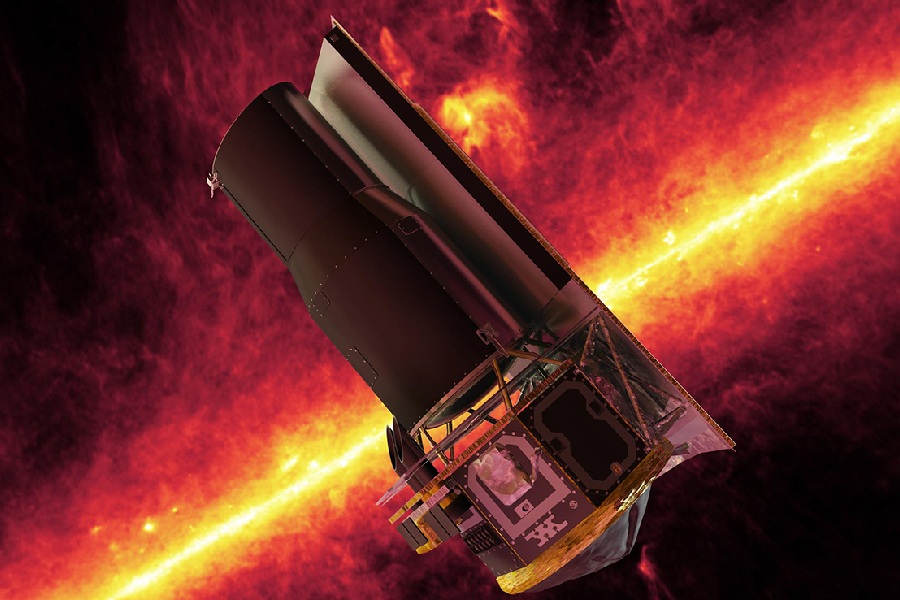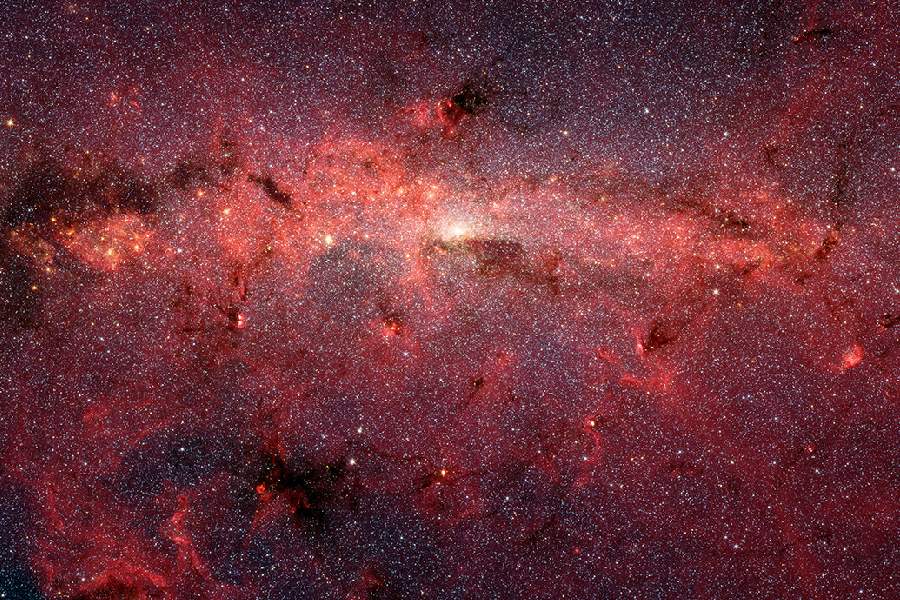Telescopes are our window into the far reaches of space, unveiling cosmic mysteries through multiple lenses. The human eye can only perceive what is revealed in visible light. But special telescopes detect infrared radiation, with its longer wavelengths invisible to us. What is an infrared telescope more specifically?
In essence, an infrared telescope captures infrared emissions from astronomical phenomena. In this article, we will explain how they reveal stars ablaze inside obscured stellar nurseries. Infrared radiation corresponds to heat energy radiating from celestial bodies.
Advanced infrared cameras in these telescopes expose an alternate, invisible cosmic vista. They penetrate dusty nebulae, showing stars bursting into being. Infrared telescopes spies stellar cradles and distant worlds’ air, imperceptible in regular light.
Stay tuned to learn more about the functionality, targets, and famous orbital observatories advancing the astronomical frontiers of what is an infrared telescope. Their distinct capacities further science’s comprehension of cosmic wonders.

What Is an Infrared Telescope?
So, what is an infrared telescope and what are infrared telescopes used for? An infrared telescope is a telescope that utilizes infrared light to detect celestial objects such as stars, planets, and galaxies. Infrared radiation passes through gas and dust clouds. It allows seeing obscured objects as well.
Infrared radiation is heat radiation. Infrared telescopes detect heat from faint, cool objects like forming stars, exoplanets, and brown dwarfs. They measure the temperatures of distant celestial bodies.
Infrared astronomy provides insights that optical astronomy cannot. Infrared telescopes use advanced infrared cameras and detectors, cooled to very low temperatures, to capture infrared signals from space. Famous infrared space telescopes are NASA’s Spitzer and Hubble.
Ground-based infrared telescopes like the United Kingdom Infrared Telescope and IRTF in Hawaii also have unique capabilities that revolutionize understanding of the cosmos.
Electromagnetic Spectrum
The electromagnetic spectrum has waves of many wavelengths. These range from long radio waves to tiny gamma rays. In between are microwaves, infrared, visible light, ultraviolet, and X-rays. Each region reveals information.
Visible light waves can be seen by human eyes. Infrared waves have longer wavelengths than visible light. Infrared radiation is essentially heat radiation given off by warm objects. It includes near, mid and far infrared regions.
In astronomy, infrared allows for studying cool, faint objects. It also penetrates gas and dust clouds, obscuring space. Meanwhile, visible light reveals other stellar features.
How Do Infrared Telescopes Work
Fundamental principles
What do infrared telescopes detect? Infrared telescopes detect infrared light from space objects. Infrared has longer wavelengths than visible light so it can penetrate dense gas and dust clouds in space.
Infrared radiation reveals cool, faint objects obscured inside stellar nurseries. Visible light signals are easily blocked or scattered by cosmic dust clouds before reaching telescopes.
So many stellar embryos buried inside remain invisible. But infrared light can pass through these thick dust cocoons to clearly show forming stars and proto-planetary systems. Infrared astronomy unveils hidden cool objects.
Detection technology
Infrared telescopes utilize specialized infrared cameras and sensors to capture this infrared radiation. These detectors are far more sensitive to infrared wavelengths than the human eye.
To pick up very faint infrared signals from distant celestial objects, these sensors need to be cooled down to extremely low temperatures. This chill reduces their own internal infrared noise. Then even very weak external infrared emissions can be detected from the cosmos.
Advanced infrared detection technology enables the detailed infrared astronomy view of space we have today.
Space Telescopes
Advantages of observing from space
Space telescopes orbit outside Earth’s atmosphere, allowing for a clear and stable view of objects in space. Unlike ground-based observation, where Earth’s atmosphere can absorb and distort infrared wavelength signals, space telescopes provide a better perspective.
Space telescopes eliminate atmospheric interference from water vapor. This blocks some infrared radiation, enabling the detection of faint cosmic infrared sources.
Challenges and solutions
Space telescopes face challenges like vacuum, micrometeorites, and extreme temps. Fault tolerance through redundancy is implemented and their cooling systems maintain proper temperature for smooth functioning.
Propulsion systems ensure proper orbital motion and orientation. These innovations enable space telescopes to provide stable, sensitive infrared observation of deep space phenomena over long durations.

Celestial Objects Detected by Infrared Telescopes
Examples of studied objects
Infrared telescopes examine a wide variety of cosmic objects and phenomena, including distant galaxies in the early universe, newly forming stars cocooned inside dense stellar nurseries, exoplanets orbiting alien suns lightyears away, and many other astronomical entities.
Cool, extremely faint objects like failed stars known as brown dwarfs and emerging protostars still enveloped in cocoons of gas and dust are also observable in infrared wavelengths. Additionally, infrared radiation can penetrate to reveal fine structural details and precisely measure the temperatures of the supermassive black holes at the centers of massive galaxies.
Infrared astronomy also enables the detection of emerging new worlds coalescing around other stars that are obscured from view in visible light by thick clouds of dust, expanding our understanding of planet formation across the cosmos.
Insights gained
The infrared observations from these specialized telescopes expose fine structural details of both galaxies and stellar nurseries by penetrating the thick layers of obscuring matter that envelop them. Infrared telescopes also enable precise measurement of the temperatures of planets, stars, interstellar clouds and other cosmic phenomena.
Combined with data from other wavelengths of light, this infrared information contributes to a much fuller understanding of objects throughout the cosmos across the entire electromagnetic spectrum.
Overall, infrared astronomy continues to provide an alternate, invisible view of many key celestial objects, moving forward the frontiers of scientific knowledge about the universe we inhabit.
Clouds of Dust and Gas in the Universe
Importance of infrared observations
Infrared radiation is able to pass through immense, dense clouds composed of gas and dust that visible light photons cannot even begin to penetrate.
So infrared telescopes are able to peer inside and reveal intricate structural details of stellar nursery nebula that are actively harboring emerging newborn stars and planets hidden from view.
Young stellar objects in the earliest formative stages have been detected sheltered deep inside the dark, opaque cocoons of gas and dust that completely obscure the vision of optical telescopes.
These unprecedented infrared views expose the embryonic early phases of stars and planets that remain unseen in visible wavelength images. The study of the beginnings of stellar life cycles relies heavily upon the capabilities of infrared astronomy.
Scientific implications
Gaining a thorough understanding of the nature and dynamics of immense interstellar clouds composed of gas and dust provides exciting new insights into the processes behind star and planet formation across our universe.
The intricate shapes and density patterns present in stellar nurseries strongly influence the prenatal environmental conditions for cosmic structures originating within them. Infrared observations are also a key resource for tracing the emergence of the very first cosmic structures from the early universe onward.
This better grasp of early galactic evolution greatly enriches theoretical models seeking to explain the origins of space itself, from the coalescence of primordial pre-galactic gas clouds to the ignition of the first stars in the cosmos after the Big Bang.
Conclusion
As explored, the infrared telescope captures invisible infrared light to reveal obscured cosmic views. From piercing dusty veils to measuring precise heat, these specialized telescopes provide unique insights into advancing astronomy. Their infrared eyes unveil stellar nurseries to alien atmospheres.
Learning about what is an infrared telescope makes us appreciate their distinct capabilities and allows a deeper understanding of cosmic phenomena, from our solar neighborhood to the early universe. By harnessing infrared wavelengths, these telescopes continue revolutionizing astrophysics.
Overall, infrared telescope innovation enables comprehending remarkable space wonders, furthering the grand quest to grasp our cosmic origins. Their infrared vision guides understanding, from stars being born to worlds far beyond.
